
Understanding Autism in Dogs: Signs, Causes, and Care for Your Autistic Dog
Overview
This article delves into the understanding of autism in dogs, shedding light on its signs, causes, and the compassionate care strategies available for affected pets. It acknowledges the emotional struggles pet owners face when observing behaviors that resemble autism, such as social withdrawal and repetitive actions. These behaviors, while challenging, can be addressed through:
- Nurturing care
- Structured routines
- Positive reinforcement
By adopting these strategies, pet owners can significantly enhance their dogs’ quality of life, fostering a deeper bond and understanding between them and their furry companions.
Introduction
Understanding the complexities of canine behavior can indeed feel overwhelming, particularly when it comes to recognizing signs of autism in our beloved dogs. With a staggering 86% of canines displaying some form of behavioral concern, pet owners often find themselves grappling with the challenge of differentiating between typical quirks and genuine issues that may need our attention. This article explores the signs, causes, and care strategies for dogs that may exhibit autism-like behaviors, offering valuable insights for those navigating this emotional journey.
How can we, as caregivers, effectively support our furry companions while nurturing an environment that caters to their unique needs?
Define Autism in Dogs: Key Concepts and Terminology
Canine Dysfunctional Behavior (CDB) encompasses a range of behavioral challenges that can be quite distressing for both dogs and their owners. It’s essential to recognize these issues, as they often resemble spectrum disorders found in humans. Understanding these behaviors can help you feel more empowered to support your beloved pet.
Canine Dysfunctional Behavior (CDB) refers to behaviors in dogs that resemble traits of an autistic dog, including social withdrawal and repetitive actions. Research indicates that a significant 86.0% of canines exhibit at least one behavioral concern, underscoring how common these issues can be. This statistic may resonate with you, especially if you’ve noticed similar behaviors in your own dog, and it highlights the importance of addressing these challenges with compassion and care.
Sensory Sensitivity is another critical aspect to consider. Many canines with developmental disorders experience heightened sensitivity to sensory stimuli, which can lead to distress in certain environments. This sensitivity might manifest as intense reactions to sounds, textures, or visual inputs, making it crucial to create familiar and soothing settings for their comfort. As a caring pet owner, ensuring your dog feels safe and secure can significantly improve their quality of life.
Repetitive behaviors such as tail chasing, pacing, or obsessive chewing are commonly observed in an autistic dog. Expert Joanna Que points out that identifying autism in canines can be challenging due to overlapping symptoms with other conditions. This complexity can be frustrating, but understanding these traits is vital for recognizing and addressing your pet’s needs compassionately.
Grasping these concepts is essential for identifying and responding to the needs of canines displaying these behaviors. Additionally, case studies like ‘Managing Repetitive Actions in Dogs’ provide practical strategies for pet owners to support their dogs. By implementing these strategies, you can create a nurturing environment that fosters your dog’s well-being and enhances your bond with them.
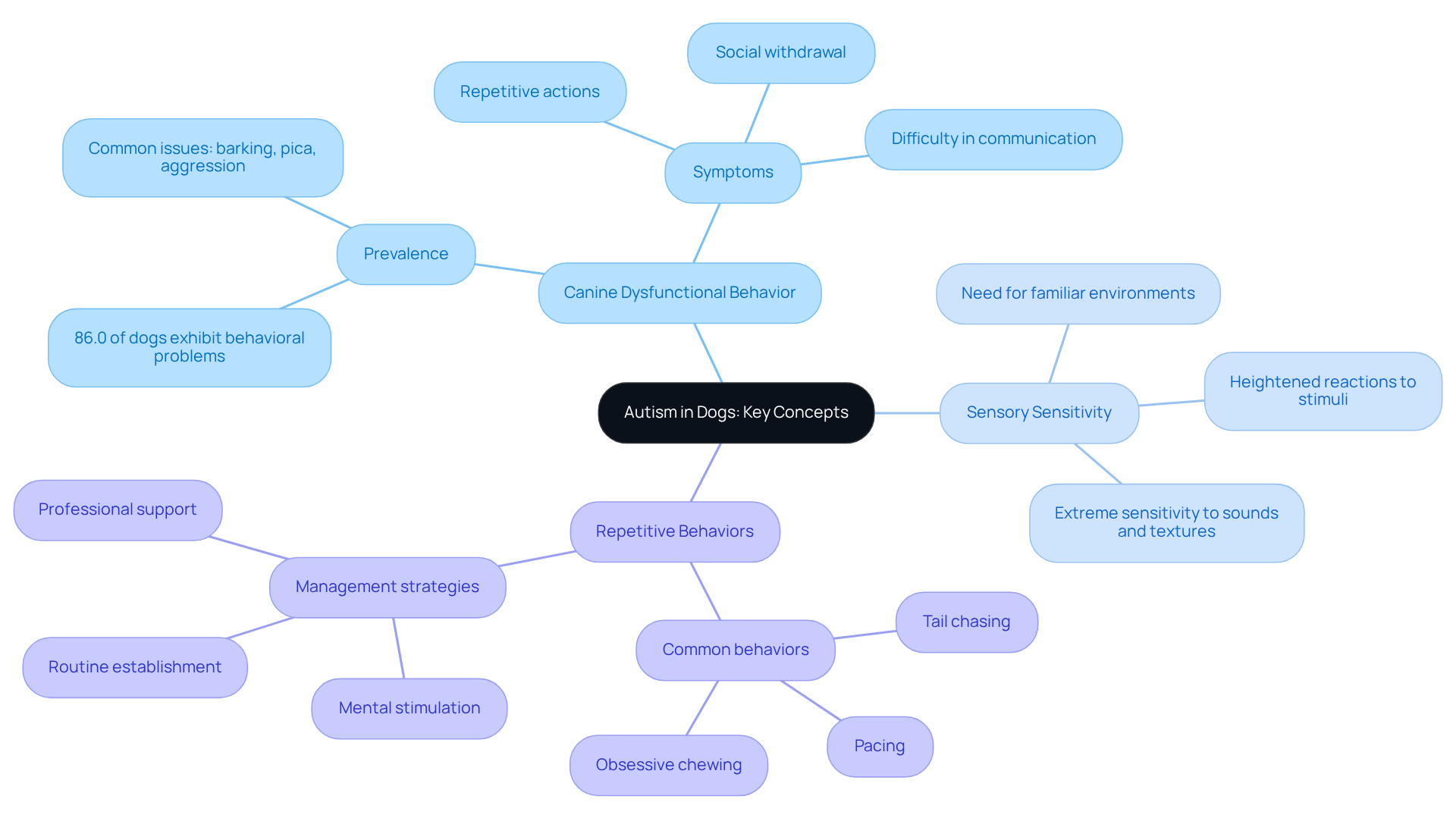
Identify Signs and Symptoms of Autism in Dogs
Recognizing the signs and symptoms of an autistic dog can be a deeply emotional journey for pet owners, as these behaviors can significantly impact their beloved companions’ quality of life. It’s important to understand that an autistic dog exhibiting autism-like behaviors may experience various challenges that can leave both them and their caregivers feeling overwhelmed.
One of the key indicators is social withdrawal. Dogs that display these behaviors often seem uninterested in interacting with humans or other dogs. This withdrawal manifests as a reluctance to engage in play and a preference for solitude, which can make it difficult for caregivers to connect with their pets. It’s heartbreaking to witness a once-playful dog retreat into isolation, leaving owners feeling helpless.
Repetitive behaviors are also common among autistic dogs. Many engage in actions such as tail chasing, circling, or excessive licking. These behaviors can be distressing, leading to physical and mental fatigue for both the dog and the owner. It’s essential to acknowledge how these patterns can create a cycle of anxiety, leaving caregivers searching for ways to provide comfort and relief.
The situation is further complicated by the sensory sensitivities of an autistic dog. An autistic dog may react negatively to loud noises, bright lights, or certain textures, which can result in anxiety or even aggression, especially in unfamiliar environments. This heightened sensitivity can be alarming for pet owners, who want nothing more than to create a safe and nurturing space for their furry friends.
Communication challenges are another critical aspect. Dogs with autism often struggle with making eye contact or responding to commands, which can hinder the bond between the dog and its handler. This barrier complicates training and socialization efforts, leaving caregivers feeling frustrated and concerned about their pet’s well-being.
Identifying these indicators is crucial for providing the appropriate care and support that an autistic dog needs. By recognizing these behaviors, caregivers can create a nurturing atmosphere that caters to their dog’s individual requirements. It’s important to note that while the occurrence of this condition in canines, such as the autistic dog, is not well documented, some pet owners and specialists have observed behaviors that resemble those seen in humans with autism.
For canines displaying signs of Canine Dysfunctional Behavior (CDB), consulting with a veterinarian or veterinary behaviorist is vital. These professionals can help identify underlying causes and develop effective management strategies. Remember, you are not alone in this journey; there are compassionate solutions available to support both you and your beloved pet.
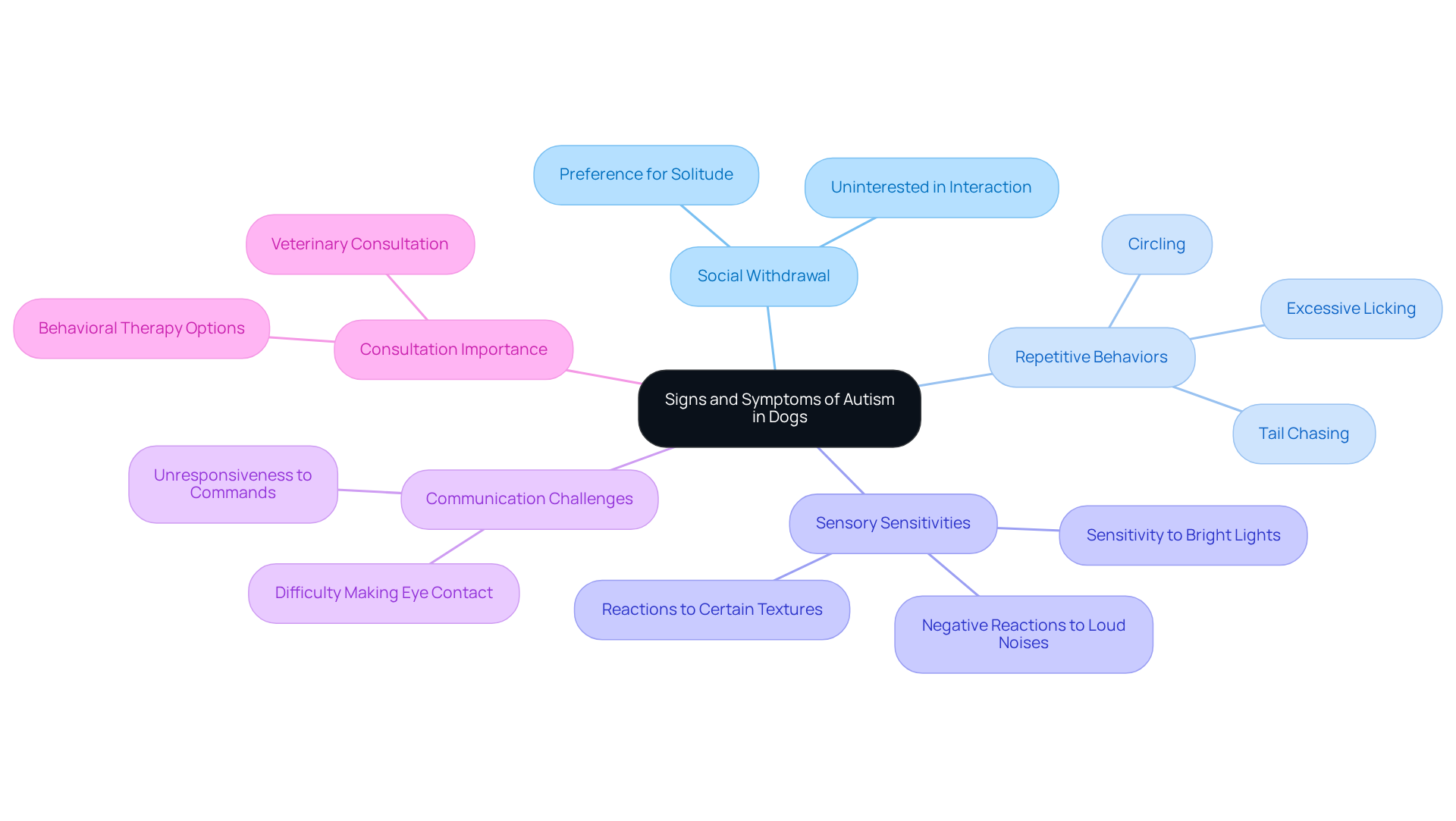
Distinguish Autism from Other Canine Behavioral Disorders
Understanding the behaviors of our beloved canines can often be a challenge, especially when an autistic dog exhibits autism-like traits that may be confused with other behavioral disorders. As pet owners, it’s natural to feel concerned and overwhelmed. Recognizing the distinctions between these conditions is vital for ensuring the well-being of your furry friend.
Separation anxiety is a common issue where dogs show distress when left alone, yet they typically seek social interaction when their owner is present. In contrast, an autistic dog may not engage socially, even when its owner is nearby. This lack of social engagement can be alarming, and it’s important to approach it with compassion and understanding.
Obsessive-Compulsive Disorder (OCD) is another behavioral disorder that can manifest in our pets. Dogs with OCD often display repetitive actions fueled by anxiety. However, an autistic dog may engage in similar behaviors without showing any signs of distress. Research highlights that OCD affects approximately 2.3% of dogs, leading to compulsive behaviors that can disrupt their daily lives. Alarmingly, there can be a significant gap of 10 to 17 years between the onset of OCD and the beginning of treatment, which underscores the necessity for accurate diagnosis and timely intervention.
Sensory Processing Disorder is yet another condition that can overlap with autism. While both involve challenges in processing sensory information, the underlying causes and expressions differ significantly. Understanding these nuances is essential for providing effective treatment and care.
By recognizing these distinctions, we can better support our pets and ensure they receive the appropriate care they need. Misdiagnosis can lead to inappropriate interventions, which may worsen their condition. Therefore, it’s crucial to approach these behaviors with a nurturing mindset, ensuring that our furry companions receive the love and understanding they deserve.
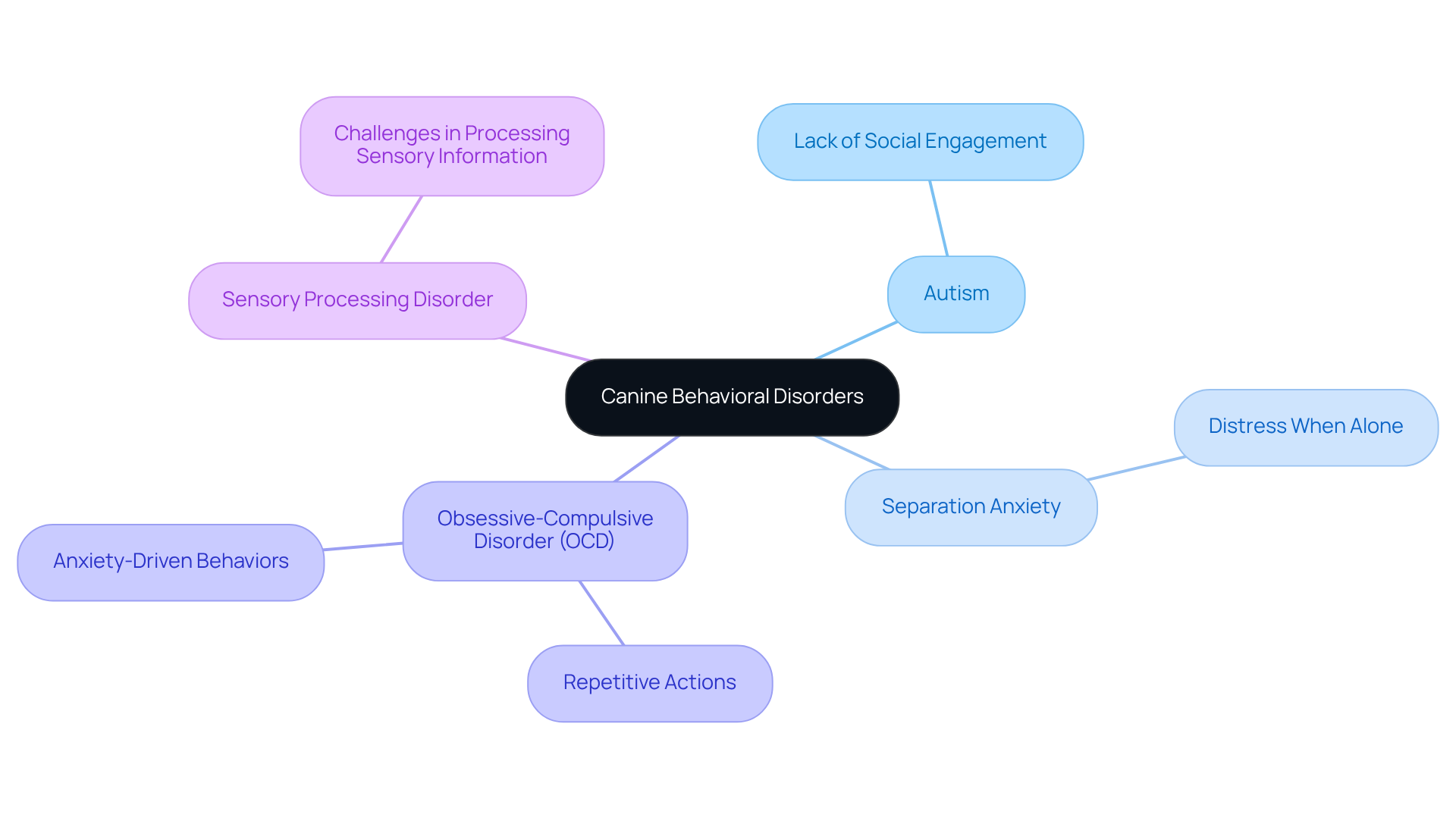
Explore Causes of Autism in Dogs
Understanding the causes of behaviors similar to those seen in an autistic dog can be quite complex and multifaceted, and it’s important to recognize how these factors may affect our beloved pets. Many pet owners may feel concerned or anxious about their dogs’ behaviors, and acknowledging these feelings is the first step toward providing the best care possible.
Genetic predispositions play a significant role in this issue. Certain breeds, such as bull terriers and miniature poodles, may be more likely to exhibit behaviors associated with an autistic dog due to inherited traits. Research indicates that a dog’s temperament can greatly influence their behavioral outcomes, including their vulnerability to anxiety and stress-related disorders. This knowledge can help us understand that some behaviors may not be entirely within our control, fostering compassion for our pets’ experiences.
Environmental influences are equally crucial. Early life experiences shape a dog’s actions, and a national study involving 4,497 dog guardians reveals that adverse experiences during the first six months—such as trauma or neglect—can significantly increase aggression and fearfulness in adulthood. It’s essential to provide proper socialization and positive interactions during this formative period to promote healthy behavioral development. Chronic stress or anxiety can also lead to withdrawal or compulsive behaviors, highlighting the need for a nurturing environment.
Neurological factors also contribute to these behaviors. Abnormalities in brain structure or function may affect social learning and emotional regulation, resulting in actions that resemble those seen in an autistic dog. For instance, dogs may avoid eye contact, engage in repetitive actions, or struggle with communication. Recognizing these challenges allows us to empathize with our pets and seek appropriate support.
Comprehending these factors is vital for pet owners who are dedicated to creating a supportive and enriching atmosphere for their animals. By understanding the complexities of autism-like behaviors, we can work together to improve their well-being and quality of life, ensuring that our furry friends feel loved and understood.
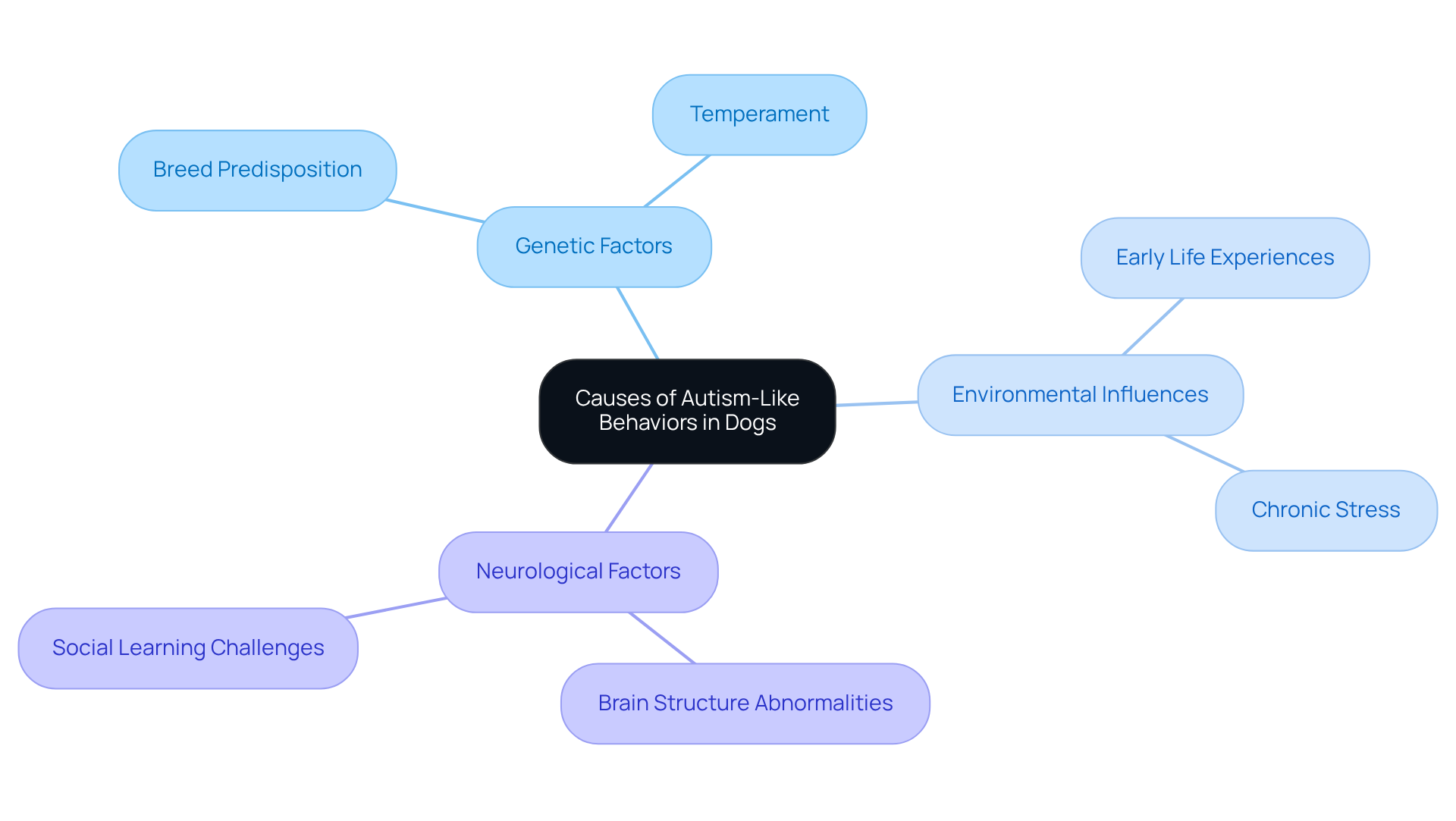
Implement Treatment Strategies for Dogs with Autism
Implementing effective treatment strategies for an autistic dog requires a thoughtful blend of behavioral and environmental adjustments that can truly make a difference in their lives and yours.
Establishing a structured routine is crucial for reducing anxiety and fostering a sense of security in dogs that are autistic. Imagine how comforting it is for them to have a predictable daily schedule, allowing them to navigate their day with confidence and ease. This consistency not only helps alleviate their worries but also strengthens the bond you share.
Positive reinforcement training can be a powerful tool in managing autism-like symptoms. By rewarding preferred actions, you can create a nurturing environment where your dog feels encouraged to communicate. For instance, using treats or praise when your dog responds to commands reinforces positive behavior and enhances your connection.
Creating a sensory-friendly environment is essential for helping dogs that are autistic feel more at ease. Picture a calm space filled with soft bedding and quiet areas, free from overwhelming stimuli that may cause stress. This thoughtful setup can significantly improve their comfort and overall well-being.
Engaging with a veterinarian or canine behaviorist can provide tailored strategies and interventions that cater specifically to your dog’s needs. Their expertise can empower you to implement effective training methods and address any specific behavioral challenges, ensuring that you are not alone on this journey.
By employing these compassionate strategies, you can significantly enhance your dog’s quality of life. Together, you can foster a more harmonious relationship and improve overall well-being, creating a loving environment where both you and your furry friend can thrive.
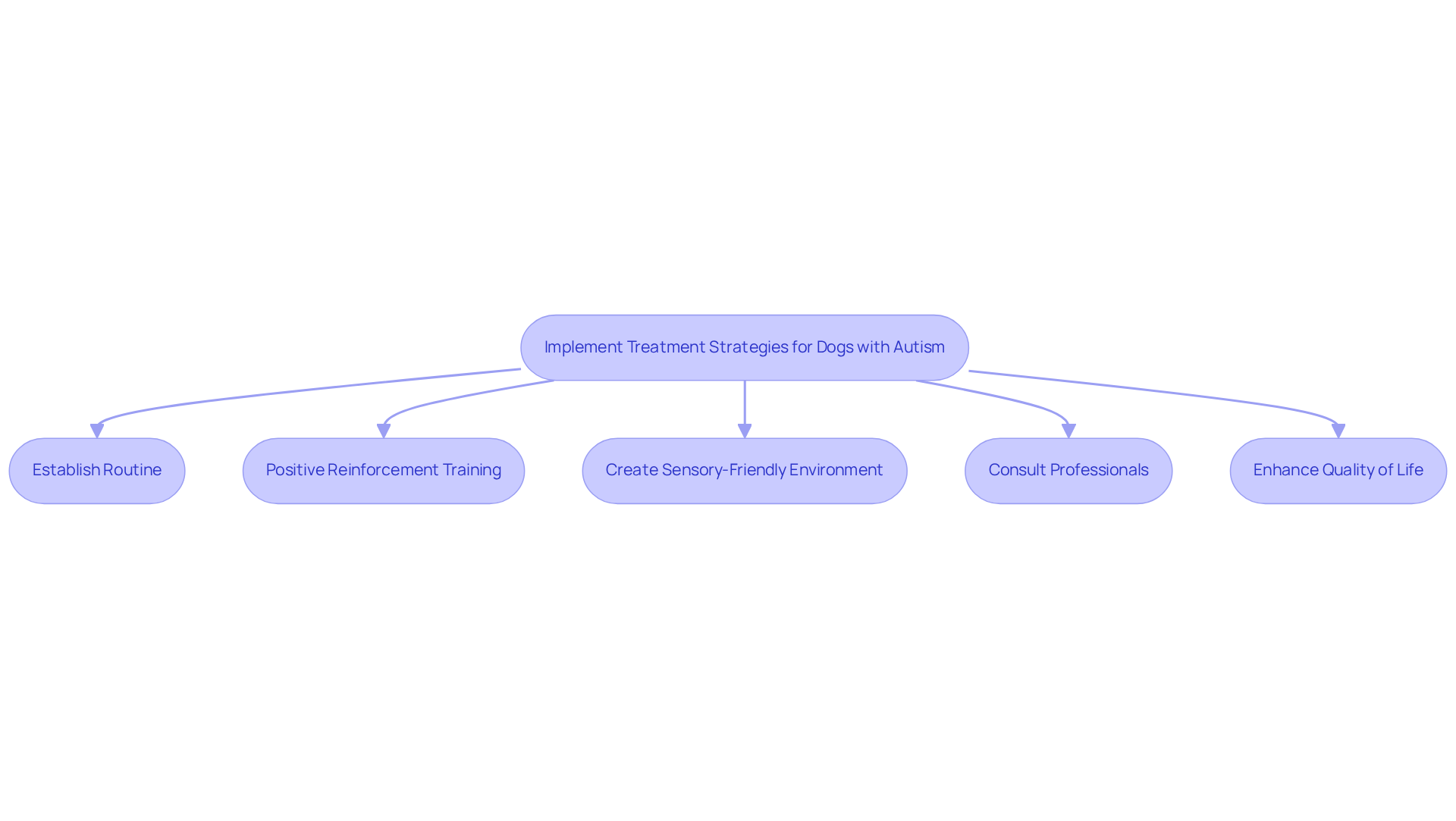
Conclusion
Understanding autism in dogs is a multifaceted journey that calls for compassion, awareness, and dedication from pet owners. Recognizing the signs and symptoms of Canine Dysfunctional Behavior (CDB)—such as social withdrawal, repetitive actions, and sensory sensitivities—allows caregivers to provide better support for their furry companions. Acknowledging the emotional weight of these behaviors fosters a deeper bond and understanding between dogs and their owners.
This article highlights key aspects of canine autism, including the distinctions between autism and other behavioral disorders like separation anxiety or OCD. It emphasizes the importance of recognizing genetic predispositions, environmental influences, and neurological factors that contribute to these behaviors. By grasping these complexities, pet owners can tailor their approach to meet their dogs’ unique needs, ensuring they receive the appropriate care and support they deserve.
Ultimately, creating a nurturing environment through structured routines, positive reinforcement, and professional guidance can significantly enhance the quality of life for dogs displaying autism-like traits. It is crucial to remember that each dog is an individual, and compassionate strategies can lead to a more harmonious and fulfilling relationship. Advocating for awareness and understanding of canine autism not only benefits the dogs but also enriches the lives of their caregivers, fostering a community of support and empathy for all pet owners.
